Knowing how to analyze your SEO competition is an important step in determining your overall keyword and SEO strategy. There are many factors involved in the process, and without the correct framework, it can get complicated.
This SEO Competitor Analysis Template will guide you through the exact steps you need to take in order to deploy a comprehensive analysis. Below the infographic, you can find a detailed explanation of each step.

We’ve tried to make the steps as clear and simple as possible, so grab your biggest cup of coffee and enjoy your reading.
- Perform Keyword Research
- Identify and Validate Your Top Competitors
- Consider your main competitors
- Add competitors targeting the same keywords as you
- Use the keywords from your previous research to spot competitors that keep ranking in top positions
- Use Site Explorer to find competitors’ top ranking keywords and add them to your research
- Select top 3-5 competitors based on rankings and frequency
- Analyse and Position Yourself Among the Competition Based On:
- Number of pages indexed for each site
- Historical link velocity trends
- Number of referring domains
- Link quantity and influence
- Webpage type/Link position/Link visibility
- Deep Link/Homepage link ratio
- Anchor text distribution
- Natural/Unnatural link ratio
- DoFollow/NoFollow link ratio
- Common anchor texts between sites
- Common domains and links between sites
- Most linked URLs (identify best-performing pages)
- Content Visibility (identify social networks where content performs best)
- Most shared pages (identify competitors’ content marketing strategies)
- Keyword position in the title
- Other On Page factors such as content quality, HTML structure, or website design
- Develop Keyword and SEO Strategy Considering:
1. Perform Keyword Research
Any competition analysis should start with a keyword research. If you don’t know the keywords you want to target, you can’t possibly know your true SEO competition. This step will also determine what level of difficulty you wish to perform the analysis at.
For example, let’s assume we’re in the shoe business and wish to open a web store. Depending on our budget, we can either start targeting very high search volume keywords or lower search volume keywords. Keep it realistic. It either takes money or time to get there. In fact, it takes time in both cases given you’re working with organic search.
To begin the keyword research process, you can open a new Excel or Google Sheets file. This is where you will write and sort the keywords you choose. Niches and sub-niches should be separated by sheets, and the keywords should be sorted by search volume.
1.1 Add top-of-mind keywords
Top-of-mind keywords are phrases that pop up in your head right away when you think about a niche. It’s like a brainstorming process. They are also frequently called seed keywords.
You can use the Google search engine to get real-time suggestions. Simply go on Google and start typing your keywords, and new ideas will appear right under the search bar. A highly competitive keyword would be, in this case, “buy shoes online”.
Phrases with the word “buy” in it are called buyer’s keywords. They are usually the most competitive, as we know from the phrase itself that people are already set to buy the product. Ranking for those keywords practically guarantees that some sales will indeed be made. Where sales are guaranteed, big players come.
A lower competition keyword can be “best shoes for …”.
More niched phrases tend to be less competitive. One reason might be the fact that they are untapped, meaning that not many people actually discovered them. They are called longtail keywords. Many think that the name is related to the number of words the phrase contains, but that’s not correct. Read this article for the correct definition. Review and comparison sites often try to rank here. People are still inclined to buy, but they might just be looking to compare products or find ideas.
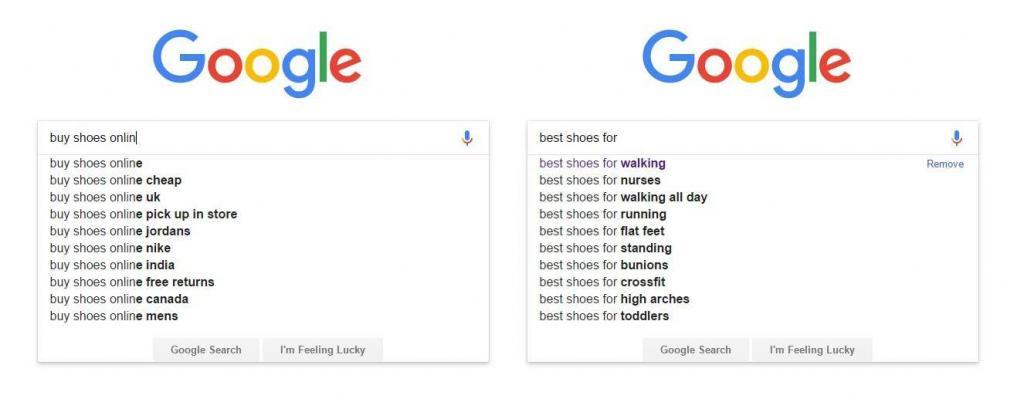
Write some of these keywords down in the Excel file.
1.2 Add seed keywords to the Keyword Explorer or Google Keyword Planner to get new ideas
Use the seed keywords you acquired from the previous step to generate a list of keywords.
You can go classic and use the Google Keyword Planner, though data is limited if you don’t have a paying Adwords account. You can try multiple keywords here, export the data as CSV, sort the keywords, and add some to your list.
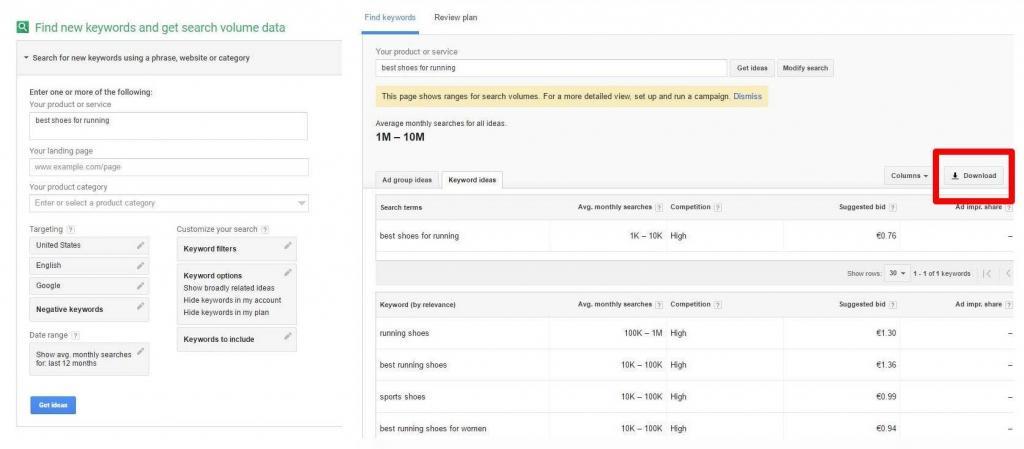
The cognitiveSEO Keyword Tool is an analysis tool that will give you great insights on the keywords you use. You’ll be able to make an idea of how difficult it is to rank for those particular keywords. It also shows you how relevant other keywords are compared to the current ones.
It’s best if the keywords you’re trying to rank for have a high search volume and a low difficulty. High search volume means the phrase is popular and many people are typing it in their browsers. Low difficulty means that not many strong competitors are trying to rank for it. Combining these two metrics will result in profitable phrases that are easy to rank for.
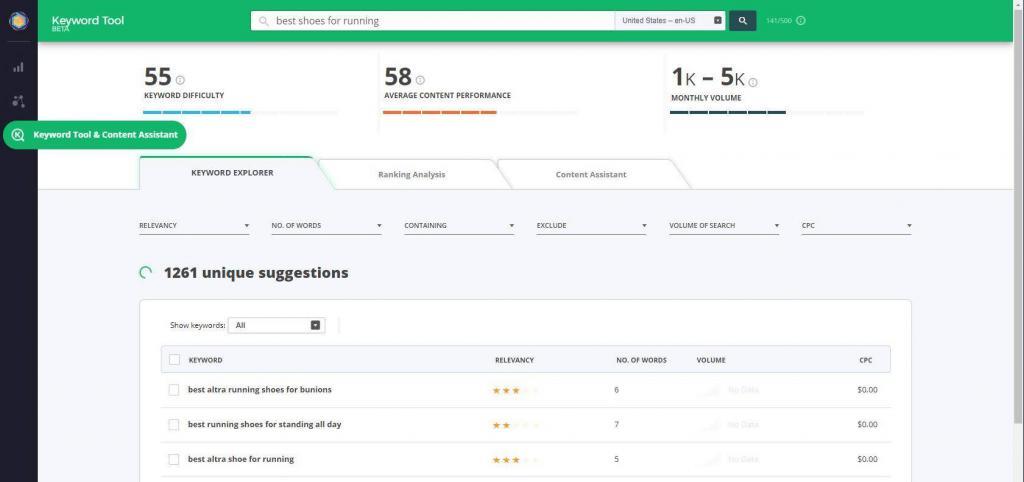
1.3 Select top keywords based on relevancy and search volume
For the purpose of this analysis example, we’ll just stick to these keywords: “buy shoes online” and “best shoes for”. One is broader and the other is narrower, but both are attractive in terms of relevance and search volume. Let’s assume that we start from the bottom (narrower keywords), but leave room for expansion in the future (broader keywords).
From these two keywords, we can observe that the broader ones tend to return root domains as results, while narrower ones return pages from websites. This is a good indication of what our homepage should be targeting, and what we should target with pages.
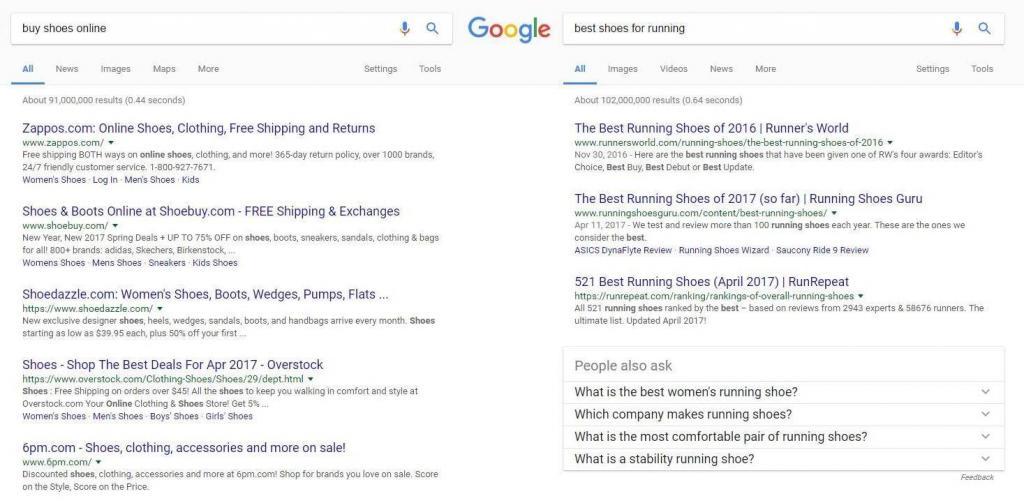
The final list should include keywords around your general niche and some current or possible (future) sub-niches. You can group them into separate sheets. This way you’ll be able to select top competitors from multiple sub-niches easier. The more keywords you’re willing to analyze, the better you’ll understand what you’re dealing with in the long run.
2. Identify and Validate Your Top Competitors
To analyze the SERPs and keyword search volume, you need to do some keyword research. Simply head to the Keyword Tool, add your targeted keyword, hit enter, and then click on SERP analysis. This will point out the top 10-100 results on the web on a chosen key phrase, and you will be able to easily identify competitors.
2.1 Consider your main competitors
If you’re already a player in your niche, then you surely already know some competitors. If you’ve been noticing a particular site ranking on top positions over and over again, you probably remember their name.
Write these websites down and consider adding them to your analysis. Most of the time, you will find these top-of-mind competitors among the researched competitors as well.
We will add bestproducts.com as our top of mind competitor. It’s a much broader website, but it does rank for more than one keyword beginning with “best shoes for”.
2.2 Add competitors targeting the same keywords as you
It’s about time we chose “our own” website for this analysis.
Let’s go with shoefinale.com. It doesn’t rank at the very top for keywords, and it has a broader domain name, which means future expansion on other sub-niches will fit it well. Also, it’s already trying to target multiple sub-niche keywords. We know this from the menu of the website.
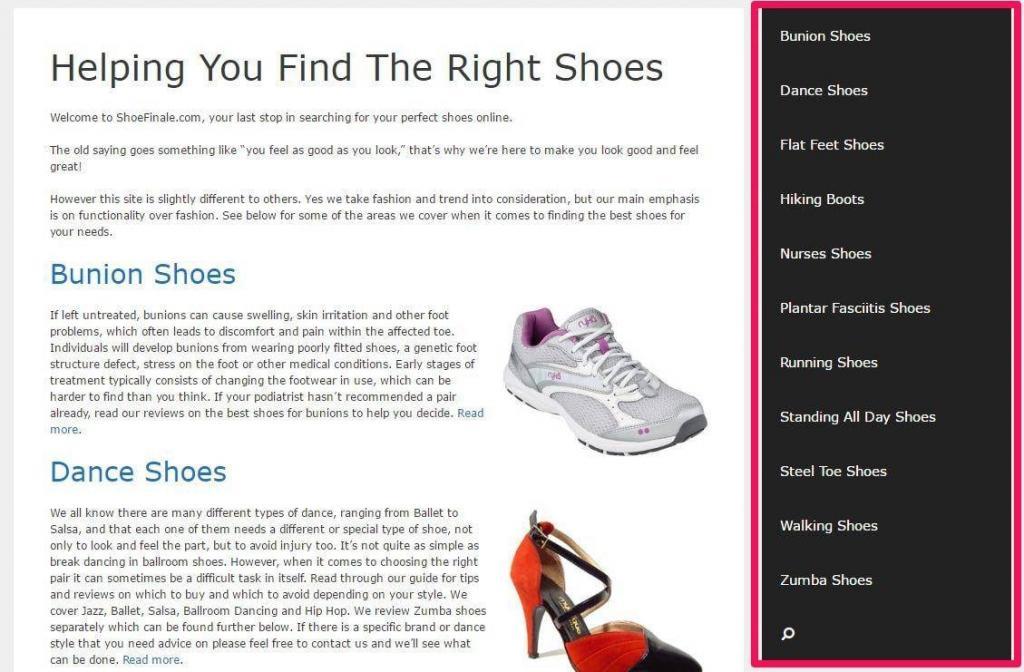
This is a hypothetical website. We don’t own this website, nor do we know who does. We only use it for explanatory purposes.
Our website seems to be targeting “top 10 shoes for running” and “best shoes for running”. Both times, the top position is taken by a page from runnersworld.com, so we’ll add it as one of our competitors.
Perform this step on most of the keywords you’re trying to rank for, or at least the most important ones. Try to notice if the same competitor shows up for the majority of keywords you’re targeting. That’s your real enemy.
2.3 Use the keywords from your previous research to spot competitors that are ranking in top positions
Our broader keyword, “buy shoes online”, has some variations, but the rankings are usually similar. A broad variation example could be “online shoe store”. If you check the top results, they are pretty similar.
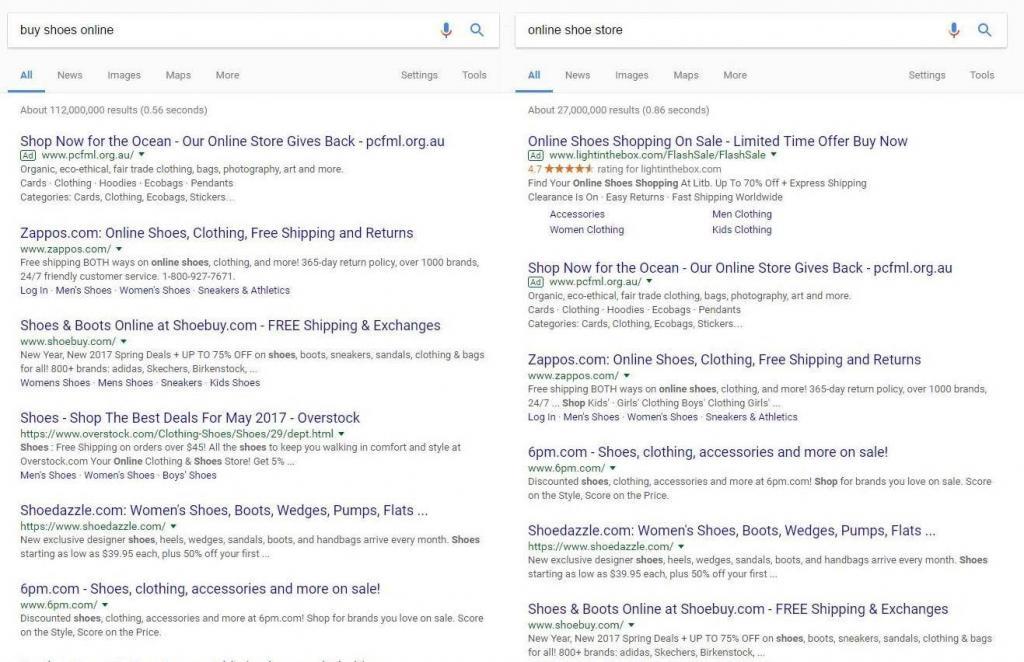
The narrower one, “best shoes for…” has many variations, and the rankings here differ significantly. We can see phrases like “best shoes for walking”, “best shoes for running”, or “best shoes for standing” as sub-niches of our market. These sub-niches we identify for our website will have different competitors most of the time.
Using the Keyword Explorer’s SERP Analysis feature, compare different keyword variations and identify competitors that show up multiple times in these variations.
Sometimes, when extremely many sub-niches are present, you might need to run multiple analyses for each sub-niche, and then compare the results of these analyses themselves to identify your true top competitors.
2.4 Use Site Explorer to find your competitors’ top ranking keywords and add them to your research
Knowing your competitor’s top ranking keywords is useful from two points of view:
- You can target those keywords too, and try to outrank the top competitors;
- You can spot other competitors that are fighting their way to the top.
Depending on the level you are at the moment, top players might not provide as good insights as a rising website would do. Over time, you can observe the journey of a website that gradually rises in the search results, and extract their practices.
To analyze your competitor’s top ranking keywords, you can use the Site Explorer ; simply enter your competitor’s domain name and hit Explore. After the data is analyzed, go to Rankings and select the targeted country. At the bottom of the page, some of the competitor’s best rankings will show up. You can add them to your analysis directly from there.
2.5 Select top 3-5 competitors based on rankings and frequency
Depending on how many sub-niches you want to target, this process can be repeated. By “this process” I mean: research keywords, and analyze the rankings and the number of Google searches.
For this particular analysis we will stick to the following 4 competitors:
- Shoebuy.com
- Bestproducts.com
- Runnersworld.com
- Runnerclick.com
Note: By the time I finished this case study, our competitor shoebuy.com bought shoes.com and redirected their domain to it. If you perform the searches, shoes.com will appear in the SERPS instead of shoebuy.com.
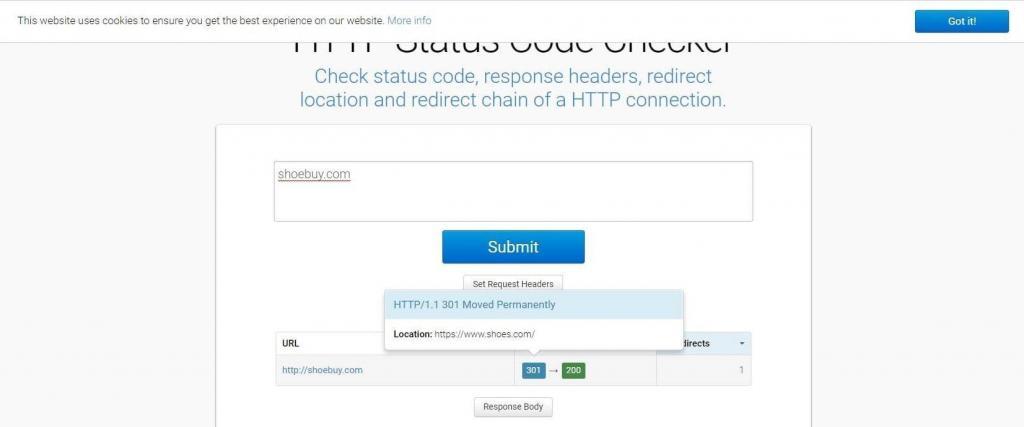
Remember that this is just an example analysis. If applicable, different sub-niche analyses can be performed to reveal the top 5 competitors.
3. Analyse and Position Yourself Among the Competition
There are many factors that contribute to a website ranking. Although competing for a single phrase usually involves more On Page factors, when comparing two sites as a whole, Off Page factors are more relevant.
The cognitiveSEO tool can help us right away. All we have to do is create a new campaign, add our site and our competitors, and the tool will provide you with all the details you need in order to have a holistic view of the situation.
After the tool completes the analysis we can go straight to the Competitive InBound Link Analysis and see where we stand compared to our competitors.
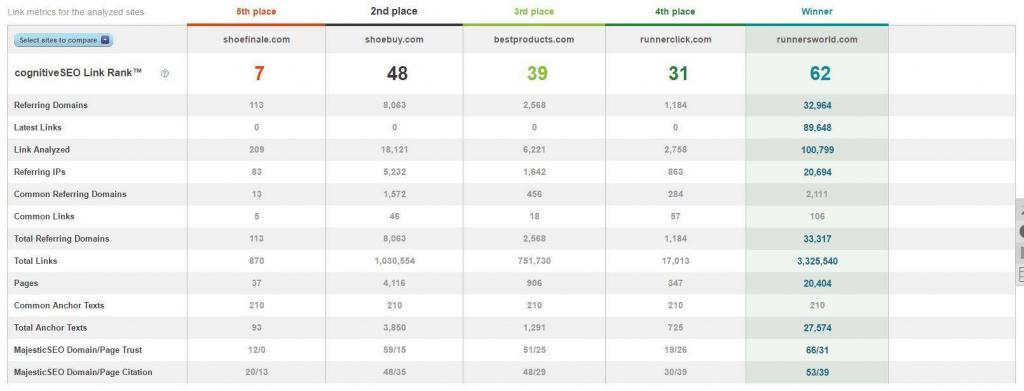
From the chart above it’s obvious that we’re pretty far behind.
Let’s find out why, by taking a more in-depth look at some of the most important factors required to have a thorough SEO competitive analysis.
3.1 Number of pages indexed for each site
First, we will take a look at the size of the site. A bigger site doesn’t necessarily mean a better one, but more search results usually mean age and experience.
To check out the number of indexed pages of a website, we can simply use the “site:” search operator in Google.
Head over to Google.com (or whatever your country extension is) and type in “site:domain.com” without the quotation marks. Replace domain.com with whatever site you wish to analyze.
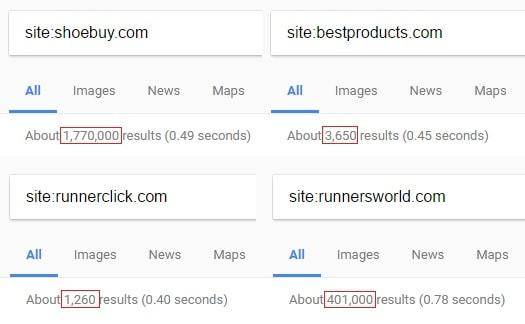
From the screenshot above we can notice that shoebuy.com has the most results. This was expected from an eCommerce website, but I must admit, over a million and a half results is pretty impressive. After taking a closer look, I spotted that they also have a couple of important subdomains. On one of them, they have a blog, which is exactly what an eCommerce website should be doing for organic search benefits.
The results might differ depending on the time and location on which the search is made.
3.2 Historical link velocity trends
We can easily correlate the number of pages indexed in Google with the age and especially the activity of the website. I’m not necessarily referring to the age of the domain itself, as this might have been purchased long before it was ever used.
Instead, we will use the cognitiveSEO Site Explorer to take a look at their backlink profile over the last 2-5 years. This will reveal when the webmasters actually took action into improving their SEO visibility.
Head over to it and type in your desired competitor. Then select the targeted time frame in the Link Velocity tab.
From the Site Explorer, we can notice that shoebuy.com and runnersworld.com both have active backlink profiles dating since 2012. The other two sites, runnerclick.com and bestproducts.com, date since mid-2015.

Now we have an idea about how long it might have taken for our competitors to get to the level they are at. To get at their level, we will have to commit to a similar amount of time, or have a greater budget/team.
3.3 Number of referring domains
The number of referring domains is one of the strongest signals pointing to the fact that the site is popular, and that it has a strong SEO presence.
Although we can also quickly check this data in the Site Explorer, the tool itself also provides this data, among other very useful information.
In our case, the winner in this category is definitely runnersworld.com, with well over 30.000 referring domains. When seeing so many referring domains, you might be thinking “spam”. This could be the case, but the rankings and link velocity indicate it’s not.
The other sites’ number of referring domains are in the screenshot below.

With only 113 referring domains, our website seems very far away from reaching the competition.
3.4 Link quantity and influence
Quantity isn’t everything. We also have to check the quality. The cognitiveSEO link influence score has a very complex algorithm to differentiate valuable links from less valuable ones.
To get a quick idea of how qualitative the backlinks of a website are, we can look at the referring domain/link ratio. If the website has a low number of referring domains but a high number of links, it probably means that most links are not of very high quality.
This usually happens when you place links in boilerplate content, such as the footer. If that website (a forum, let’s say) has one million pages, you will get one million backlinks, all coming from only one domain. All those links are not really valuable, and in a “link in footer” case, the most valuable one would be the one coming from the homepage.
For our competitor shoebuy.com, the link/domain ratio is pretty high, considering it has one million links and only 8000 referring domains. This is not necessarily a bad thing. The links might still be coming from high authority domains. Usually, the closer the ratio is to 1, the higher link quality is.
Here is the link influence graphic for shoebuy.com, from the tool. It confirms our previous assumptions. Most of the links don’t have a very high influence, but they are coming from pretty authoritative domains.

Although the scale is not the same (only has 113 referring domains and 870 links), our test website shoefinale.com has a similar ratio in the link influence section. If we decide on building more links to it, it’s a good idea to get them from domains we don’t already have links from and try to make them editorial rather than site-wide.
3.5 Webpage type/Link position/Link visibility
The webpage type can help us understand what types of websites our competition has backlinks from. For example, we can notice that links towards shoebuy.com are evenly spread between blogs, eCommerce sites, and forums.

The link positioning refers to the type of content that surrounds the placement of the link. For our eCommerce competitor, we can see that most of the links come from blog posts and forum threads. This is helpful because we can try to replicate good ranking competitor link profiles.

The link visibility tells us about the location of the link on the page itself. If it is up and visible when the website first loads, it will show up as “above the fold”. These are high-quality links, and are usually harder to obtain, especially in a natural manner.

Knowing more about our competitor’s backlinks can help us determine what sort of overall SEO strategy we should develop. If a competitor ranks well for a long time, they have a strong backlink profile that helps them. If we spot very big discrepancies between the distribution, for instance, links coming just from article or web directories, we can assume that their profile is unnatural and the risk getting penalized will appear sooner than later.
3.6 Deep Link/Homepage link ratio
It’s expected from an eCommerce site like shoebuy.com to have more deep links. People tend to discuss products in forums or write reviews about them in blog posts. Occasionally, the homepage might be linked to as well.
Homepage links are more valuable though, especially if they come from highly influential domains. If we expand the high influence links section from the tool, we can notice that the links point to the root domain or a subdomain.
3.7 Anchor text distribution
A long time ago, anchor texts clearly influenced what keywords a page ranked for. After being overly used, they are now seen as spammy, and the habit is penalized by Google’s Penguin updates.
Nowadays, Google prefers to see a more branded anchor text distribution. The more branded the anchor texts are, the more natural the backlink profile is seen.
We can preview the distribution of the anchor texts our competitors use and have used. If too many of these are exact keyword matches, then the anchor texts might be considered spammy by Google, and unnatural as well.
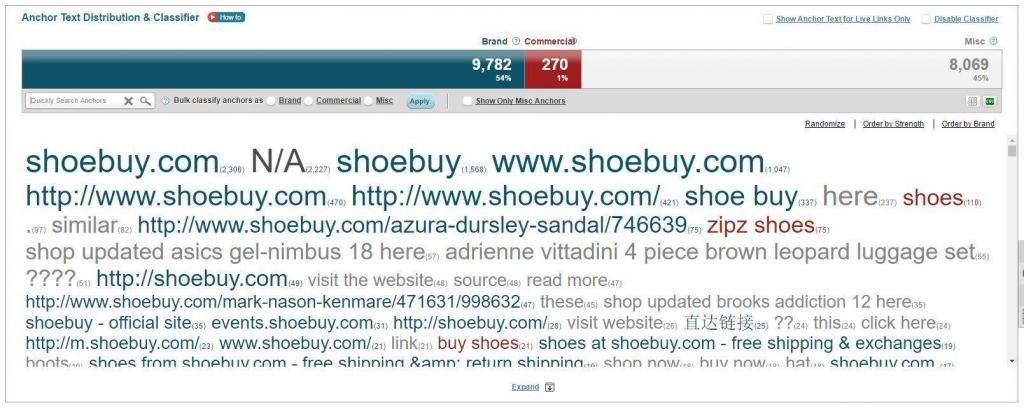
Our competitor has a decent branded percentage, with 54% of the anchor texts including a direct link or the domain/brand name in some form. The test site shoefinale.com stands a little behind, with only 31%. This rate should be increased in the future.
To check if the competitors have been stuffing their keywords in the anchor texts, we can do a simple search for the keywords themselves.
shoebuy.com doesn’t have any anchor text containing our target phrase“buy shoes online”, but it does have some anchor texts containing “buy shoes”.

Our more narrow niche competitor, runnersworld.com has similar results. No links contain “best shoes for running” in the anchor, but combined, about 250 links contain the keywords “running shoes” and “best running shoes”. Still, this isn’t much in their huge amount of referring domains and links.
3.8 Natural/Unnatural link ratio
To thoroughly analyze a website backlink profile, we can use the best and most popular feature of our SEO tool, the Unnatural Link Detection Tool.
Note that before running the tool, we have to correctly sort the anchor texts mentioned at step 3.7. The tool better classifies the links if 70% of the anchor texts are marked as branded or commercial.
From what we’ve seen so far, we can assume that shoebuy.com’s link profile will look pretty natural. The tool confirms this, but there is still room for improvement.

Google does not forget, nor does it forgive. At least not easily, but the cognitiveSEO tool can help you convince them to do so. You can select links and export them in a disavow format which you can then upload to Google, as a sign of repentance.
3.9 DoFollow / NoFollow link ratio
Although DoFollow backlinks are the only ones that pass the credits to our website, NoFollow links are also part of the natural landscape. Try to obtain as many DoFollow links as you can, but try to not remove the NoFollow natural ones.
These days, most websites, such as forums, have the links set to NoFollow by default.
I expected to see more NoFollow links but, apparently, on average, less ¼ of the links are NoFollow. This might be due to the fact that sites which have been for a longer time in the SEO game might have built links according to deprecated techniques. Some time ago, links used to be DoFollow by default.
3.10 Common anchor texts between sites
Analyzing the common anchor texts between the sites will help us stop on the anchor texts we can easily use ourselves.
Most of the time, selecting all 5 sites will result in general phrases like “click here” or “visit our website”.

Clicking on each anchor text will show us the exact links that used them. We can even export a list of these links and see which ones we could potentially get linked on as well.
3.11 Common domains and links between sites
Common domains and links are another great link building opportunity you can take. If two or more competitors have links on the exact same location, maybe it’s something you should look at as well.
And it’s not even difficult to identify and export these links. You have the ready-to-use charts within the cognitiveSEO competitive analysis.
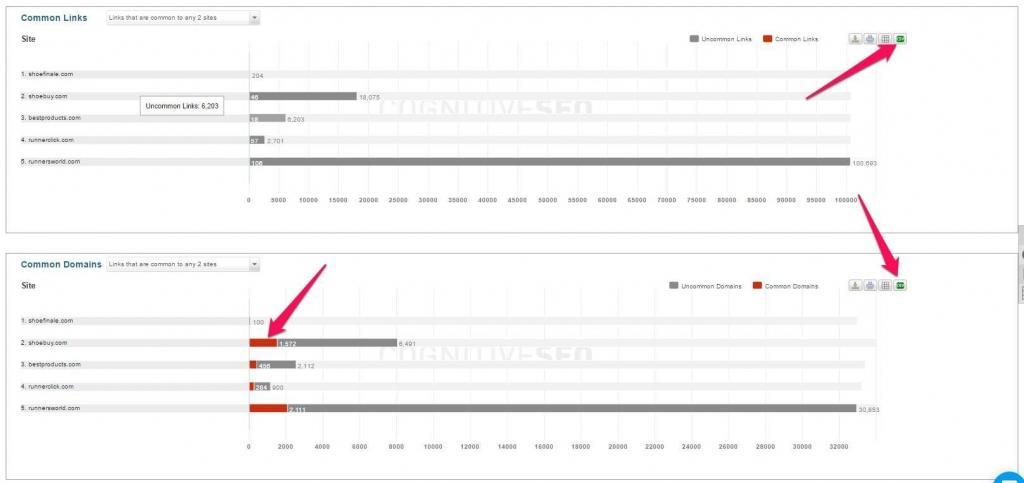
This way you can know exactly what domains you should pursue, what link building opportunities you have, and so on.
3.12 Most linked URLs (identify best-performing pages)
Most of the times, the most linked URL will be the homepage of a website.
The other pages in the top linked pages are usually the best-performing content of a website. By looking at these pages we can determine what type of content performs best in terms of acquiring backlinks. We can also analyze the On Page factors of these pages, and see what type they are. Are they a blog post or an infographic?

You can make an idea of what content you can create to easily acquire backlinks.
3.13 Content Visibility (identify social networks where content performs best)
Social media is a very important metric when analyzing our competition. We’ve run a study trying to figure out whether social signals are a ranking factor or not and the results will surprise you. The more popular a piece of content is in the social media field, the faster it seems to climb in the search engines.
The Competitive Content Visibility section from the tool gives us an overview. To be honest, it’s almost scary. Our top competitor has over 15 million shares across all the social platforms. That’s a pretty high competition.

From this graphic, we can see that the shoes niche does well on Pinterest. Facebook also does well, but this is usually obvious for the biggest social media platform in the world.
Another interesting thing is that our top competitor is trying to be Google’s best friend by using Google+, a platform often omitted by everyone. This can potentially give a very big advantage over competitors, especially at an early stage.
To see so many social shares on Google+ though (more than half of the Facebook ones) leads me to believe they are not all user-generated.
3.14 Most shared pages (identify competitors’ content marketing strategies)
Most shared pages are closely related to most linked pages. We have to keep in mind, though, that on social media things work differently.
Pictures are the most shared type of content (over 90%). We can take a look at the graphs in the Content Visibility for each competitor to find out more.

We can notice from our competitor runnerclick.com that top lists do really well on Facebook. We can analyze their posts and get title or content ideas.
For instance, within our case study, a great performer is an interview of an inspirational runner that overcame obesity and motivated many people.
In the sports niche, it seems like people like inspirational articles/posts and top lists of the products they need to get started or succeed in something.
3.15 Keyword position in the title
Let’s also talk a little about some On Page factors. On a greater scale, a competitor’s backlink profile and social media presence are far more important than what’s happening on their site. I’m not saying content isn’t important, but from one point ahead, some websites can rank even with medium quality content.
We all know from plugins like Yoast SEO that it’s really important to have the exact keyword at the very beginning of the title. Miss that, and you start getting red lights everywhere in the plugin.
Although our target keyword is “best shoes for running”, runnersworld.com ranks on the top position with “best running shoes” in the title. These days, Google is able to differentiate between similar keywords.
If a top-ranking competitor doesn’t have the keyword at all in the title (not even similar) it could be an indication that their Off Site presence is very strong. This only applies when the website outranks other sites that clearly do include the keyword.
If no websites in the top page results have the keyword clearly inserted in the title, you might have found yourself a goldmine.
3.16 Other On Page factors such as content quality, HTML structure, or website design
You can take a look at the top pages of the website to spot flaws in the On Page SEO, some that you might take advantage of.
One of the most crucial ones is mobile friendliness. If a website is not mobile friendly, it will be penalized by Google’s update (back from 2015).
Your website is expected to display itself correctly on every type of device, be it desktop, laptop, tablet, or smartphone. You can also check the cross-browser compatibility. You will be surprised at how many people use Mozilla or Microsoft Edge.
The design can also be considered. Take a look at the overall design. If it looks old and sluggish, you can also win some points over this. Even if your competitor outranks you, people might bounce off their site and stick onto yours. Do your best to improve the user experience. Also, keep an eye on more subtle things like the placement of calls to action.
You can use the Google PageSpeed insights to take a look at their homepage’s HTML structure. The homepage will usually give a similar result as the rest of the pages, but you can always double check.
You can also use the Content Assistant from the Keyword Explorer to check the top performing pages spotted at steps 3.12 and 3.14. Also, use it to improve your own content performance. Add recommended keywords, and remove ones you use too much.
4. Develop the Keyword and SEO Strategy
Now that we have covered these important ranking factors, we can draw some conclusions.
We now understand that homepage backlinks with above-the-fold visibility are probably the best type of links you can get. They usually have a branded anchor text. This helps SEO in the long run, and Google loves it. It also means that the content is promoting your brand (since your brand has been mentioned in the first paragraphs). The organic traffic acquired with this type of strategy will stick.
Other types of links placed lower in the content, in short paragraphs or in forum posts, are usually deeper links, pointing to products or other pages.
From the Content Visibility section, we determined thabest-performingorming pages are top products lists and motivational articles.
Although the competition is very tough, do not abandon all hope!
An SEO competitive analysis’ purpose is to determine where we are right now compared to our competitors, and help us develop our strategy to match their level. An overall SEO strategy is different from a keyword specific strategy.
When developing your plan, keep in mind the following:
4.1 Number of competitors in SERP
If you see a lot of very strong competitors in the search results, expect for more to come. The over-saturation argument is an illusion, a myth. There are always new startups, new smart people that will be able to compete in any niche. And you know what? This includes you, too.
It does require time and effort, but ask yourself this question: Would you rather have tiny sites like back in 2012, or would you rather dominate your whole niche in the search engines?
It was by chance that the competitors I chose for this analysis were quite tough. Focusing on other sub-niches might reveal easier ones. Climb your way up to the top, one step at a time. Try to first outrank competitors that are only slightly higher than you, and only after catch up with the big ones.
4.2 Your rankings vs your competitors
The difference between your rankings and your competitors can be an indication of how much effort you have to put in to reach that level.
If you only rank on the 5th or 6th page for a high competition phrase, it might take a while to reach the top results. If the competition isn’t very hard, it’s easier to jump for page to page. Keep in mind that it can go both ways if you’re not careful.
4.3 Keywords volume and relevance
Take a good look at the volume of the phrases you want to target. Try to get ideas related to the types of content we identified as popular and well-performing in step 3.14. In our case, there were the top lists and motivational articles.
Also, make sure that the phrases are relevant to the content your site has to offer. If the users don’t find what they are looking for, the will bounce off. Your rankings will decrease and all the work will go to waste.
4.4 Profitability of respective keywords
It’s not only about how many searches a keyword has. Generally, there are two types of keywords: informative and buyer. Buyer keywords are profitable in the short run. People that come to your site through a buyer’s keyword are already set to buy something. Informative keywords can help you grow your emails list. Make sure you don’t waste this traffic by not having a “subscribe” section on your page.
To find out if a keyword is profitable, take a look at the CPC (cost per click). If people pay for ads on those keywords, you know they must be getting something back. You can use our Keyword Tool or Google Keyword Planner again.
If the SEO competition is hard and the bids are very low, it’s definitely not worth the effort.
4.5 Your SEO visibility and optimization vs your competitors
This part actually refers to the analysis itself. Try to take into consideration all the factors previously mentioned.
If you’re going to jump into the battle, make sure you are ready to face what you’ve discovered. Also, keep in mind that these competitors will continue growing.
4.6 Time / budget required to create and optimize content accordingly
In the game of SEO, there’s no room for the weak. Hit and run types of websites no longer perform so well. Even if they do, most times the short-term profits don’t cover the expenses required to get them up and running.
Try to estimate an amount of time it will be required to reach a certain level. You can trade money for time and outsource some or most of the work. Don’t try to build too many links at once though. A natural profile should have a linear link velocity.
By using our set of SEO tools you will be able to find out exactly where you stand compared to your competitors. I hope this guide will help you determine whether it’s worth starting a website in a particular niche and assist you in developing your SEO strategy if you’re already in it.
If you want to share any insights, feel free to comment in the section below!

 Site Explorer
Site Explorer Keyword tool
Keyword tool Google Algorithm Changes
Google Algorithm Changes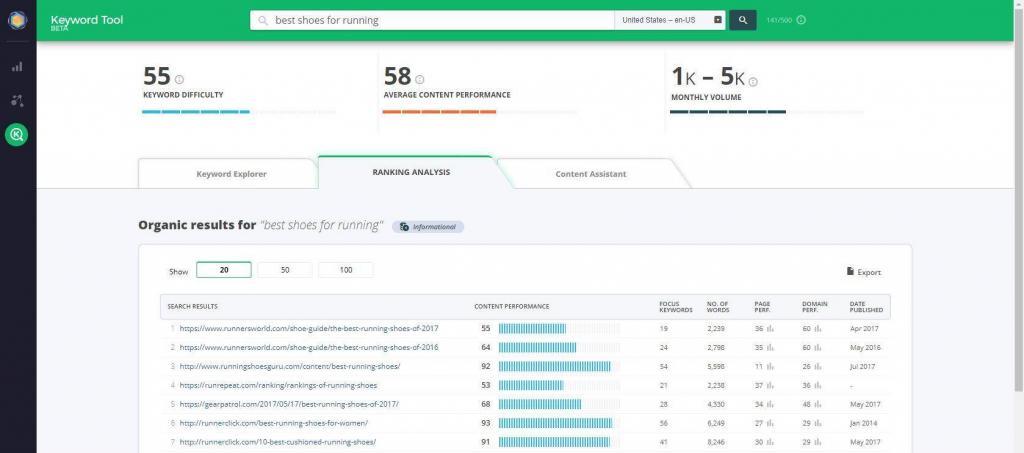

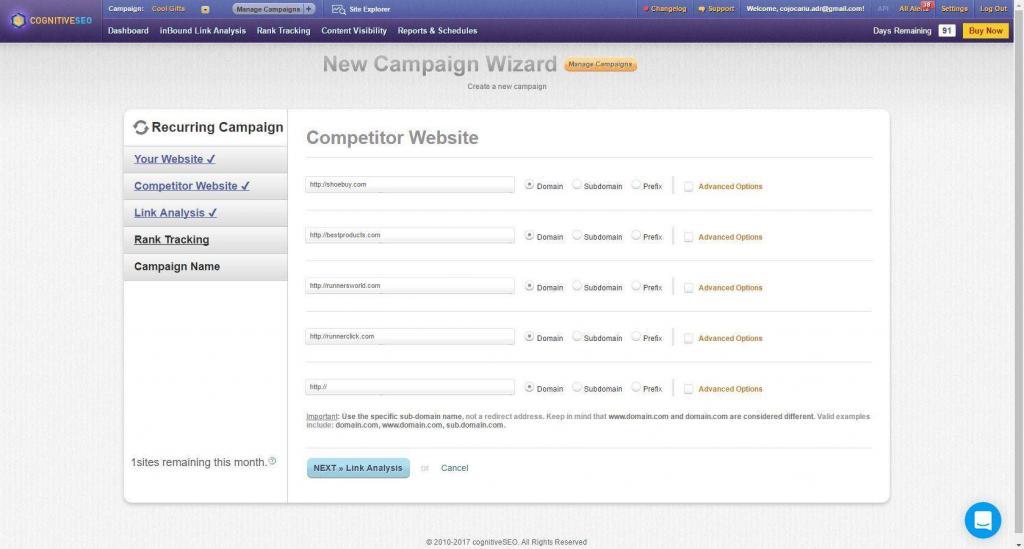
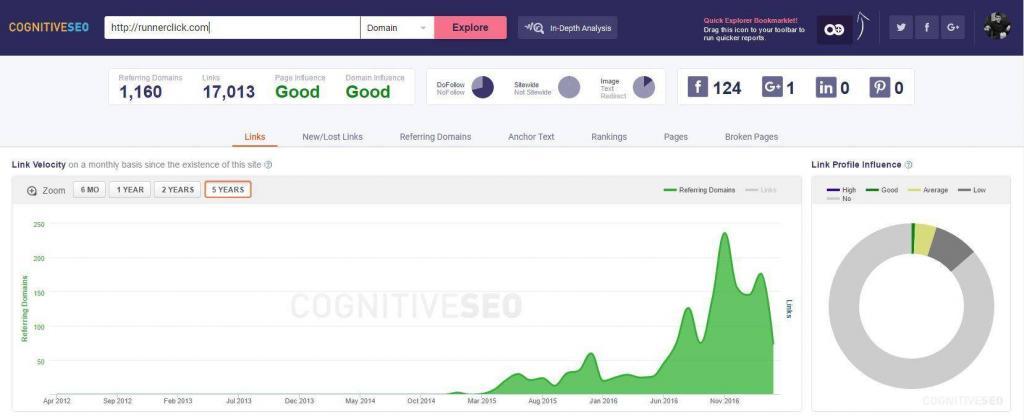
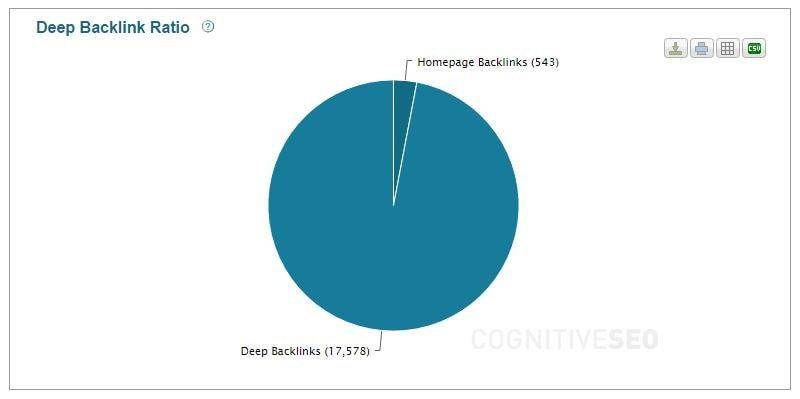


Adrian, I really like how you jump right into the keyword research and competitor analysis, as someone who does SEO for a living; I agree 100% that these two simple steps will make or break your SEO campaign.
PS just followed you on twitter.
Thanks, Mike! Glad we’re on the same page about that. I usually follow everyone back and I’m doing my best not to miss anyone 🙂
Make sure you also follow @cognitiveSEO
After looking at a handful of the blog articles on your blog, I honestly like the way you are writing your blogposts. This site really has all the information and facts I needed concerning SEO subject and didn’t know who to ask. Your articles has really peaked my interest. Thank you for providing these details.
Tib, that’s reinforcing and it motivates me to want to write even better 🙂 Thanks!
Competitor analysis provides both an offensive and defensive strategic context to identify the available opportunities. Competitor analysis is really important if you want to stay in the industry.
excellent article!
There are very few articles on competitor analysis in SEO this step by step guide covers all the aspects in a very beautiful way.
appreciated.
Great article, you’ve explained the topic well and covered all the important bases.
I would also throw in checking each competitor’s review profile, especially important for e-commerce.
I would check which review system(s) they are using and if their review stars are appearing in Google results.
Adding a review system which reports to Google can have a significant effect on both ranking positions and customer trust.
Top content here for marketers, thanks for sharing your insights.
Fantastic read Adrian! I’m gonna go ahead and make changes on my websites based on what you said above.